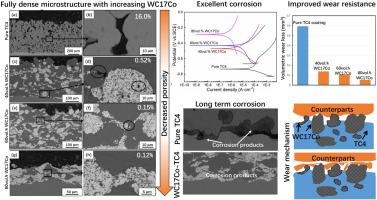Journal of Materials Processing Technology ( IF 6.3 ) Pub Date : 2021-05-21 , DOI: 10.1016/j.jmatprotec.2021.117231 Ruihong Cheng , XiaoTao Luo , Guosheng Huang , Chang Jiu Li

|
Although cold spray is a potential alternative to produce high quality Ti-based coatings due to its low process temperature, the cold sprayed Ti or Ti-based alloys usually exhibit a porous microstructure and thus cannot provide effective corrosion protection for the substrate and behave poor wear resistance. In this work, an additional forging/hammering effect for the Ti alloy coatings was introduced by mixing large-sized WC17Co particles into TC4 powder. During spraying, the impact of the large-sized WC17Co particles could plastically deform the deposited TC4 particles and therefore in-situ densify the deposited TC4 coating layer. The embedded WC17Co particles would help to improve the wear resistance of the coating. The effect of WC17Co content in the feedstock powder on microstructure, corrosion and wear performance of the coatings was examined. The porosity of WC17Co-TC4 composite coatings was reduced from 16 % to below 0.5 %. The composite coatings possessed excellent corrosion protection to substrates and the 80 vol.% WC17Co-TC4 composite coating showed the best corrosion resistance. As compared with the pure TC4 coating, the corrosion rate was reduced by 100 times and no corrosion production was observed at coating/substrate interface even after 1000 h salt-fog corrosion test. An increasing trend was detected in wear resistance with the proportion of WC17Co in the feedstock. The 80 vol.% WC17Co coating performed 10 times wear resistance higher than the pure TC4 coating. It is attempted to provide a new approach to develop corrosion and wear resistant Ti and Ti alloy coatings by cold spray.
中文翻译:

通过在冷喷涂中对大型WC17Co颗粒进行原位锻造,可实现具有完全致密的微观结构的耐腐蚀和耐磨的WC17Co-TC4复合涂层
尽管冷喷涂由于其较低的工艺温度而成为生产高质量Ti基涂层的潜在替代方法,但是冷喷涂的Ti或Ti基合金通常显示出多孔的微观结构,因此无法为基材提供有效的腐蚀保护并具有较差的磨损性能抵抗性。在这项工作中,通过将大尺寸的WC17Co颗粒混合到TC4粉末中,为Ti合金涂层引入了额外的锻造/锤击效果。在喷涂过程中,大尺寸WC17Co颗粒的撞击可能使沉积的TC4颗粒发生塑性变形,因此就地致密化了沉积的TC4涂层。嵌入的WC17Co颗粒将有助于改善涂层的耐磨性。检查了原料粉末中WC17Co含量对涂层的微观结构,腐蚀和磨损性能的影响。WC17Co-TC4复合涂层的孔隙率从16%降低至0.5%以下。该复合涂层对基材具有优异的腐蚀防护性能,并且80vol。%WC17Co-TC4复合涂层表现出最佳的耐腐蚀性。与纯TC4涂层相比,腐蚀速率降低了100倍,即使在经过1000小时的盐雾腐蚀试验后,在涂层/基材界面也没有观察到腐蚀产生。随着原料中WC17Co的含量的增加,耐磨性得到了提高。80%(体积)的WC17Co涂层的耐磨性是纯TC4涂层的10倍。试图提供一种通过冷喷涂来开发耐腐蚀和耐磨的Ti和Ti合金涂层的新方法。该复合涂层对基材具有优异的腐蚀防护性能,并且80vol。%WC17Co-TC4复合涂层表现出最佳的耐腐蚀性。与纯TC4涂层相比,腐蚀速率降低了100倍,即使在经过1000小时的盐雾腐蚀试验后,在涂层/基材界面也没有观察到腐蚀产生。随着原料中WC17Co的含量的增加,耐磨性得到了提高。80%(体积)的WC17Co涂层的耐磨性是纯TC4涂层的10倍。试图提供一种通过冷喷涂来开发耐腐蚀和耐磨的Ti和Ti合金涂层的新方法。该复合涂层对基材具有优异的腐蚀防护性能,并且80vol。%WC17Co-TC4复合涂层表现出最佳的耐腐蚀性。与纯TC4涂层相比,腐蚀速率降低了100倍,即使在经过1000小时的盐雾腐蚀试验后,在涂层/基材界面也没有观察到腐蚀产生。随着原料中WC17Co的含量的增加,耐磨性得到了提高。80%(体积)的WC17Co涂层的耐磨性是纯TC4涂层的10倍。试图提供一种通过冷喷涂来开发耐腐蚀和耐磨的Ti和Ti合金涂层的新方法。与纯TC4涂层相比,腐蚀速率降低了100倍,即使在经过1000小时的盐雾腐蚀试验后,在涂层/基材界面也没有观察到腐蚀产生。随着原料中WC17Co的含量的增加,耐磨性得到了提高。80%(体积)的WC17Co涂层的耐磨性是纯TC4涂层的10倍。试图提供一种通过冷喷涂来开发耐腐蚀和耐磨的Ti和Ti合金涂层的新方法。与纯TC4涂层相比,腐蚀速率降低了100倍,即使在经过1000小时的盐雾腐蚀试验后,在涂层/基材界面也没有观察到腐蚀产生。随着原料中WC17Co的含量的增加,耐磨性得到了提高。80%(体积)的WC17Co涂层的耐磨性是纯TC4涂层的10倍。试图提供一种通过冷喷涂来开发耐腐蚀和耐磨的Ti和Ti合金涂层的新方法。%WC17Co涂层的耐磨性是纯TC4涂层的10倍。试图提供一种通过冷喷涂来开发耐腐蚀和耐磨的Ti和Ti合金涂层的新方法。%WC17Co涂层的耐磨性是纯TC4涂层的10倍。试图提供一种通过冷喷涂来开发耐腐蚀和耐磨的Ti和Ti合金涂层的新方法。



























 京公网安备 11010802027423号
京公网安备 11010802027423号